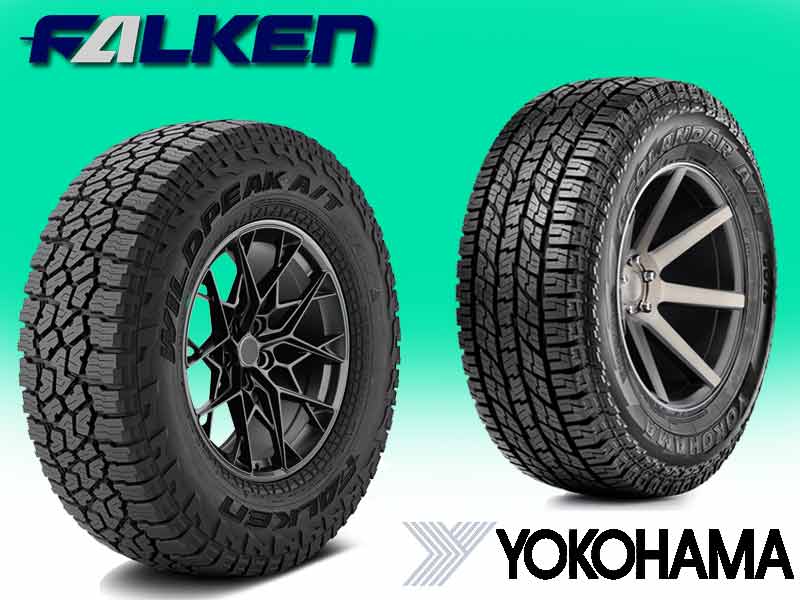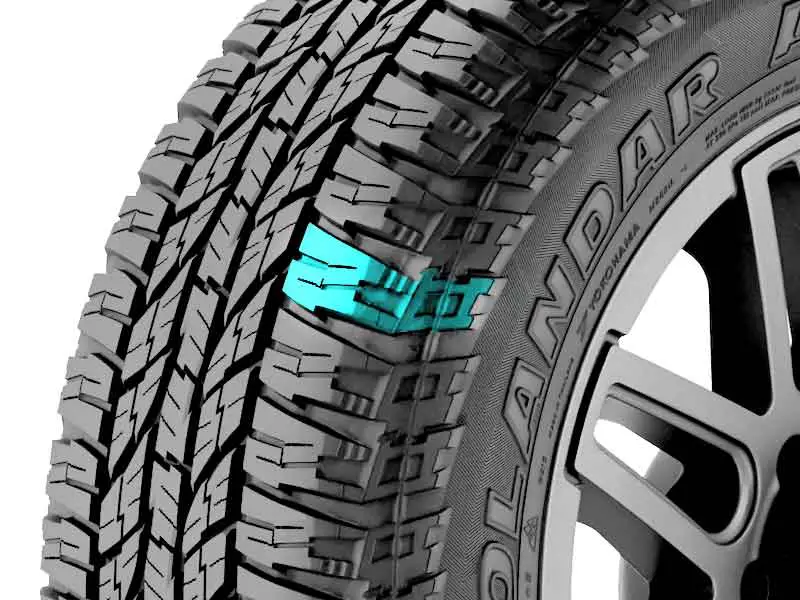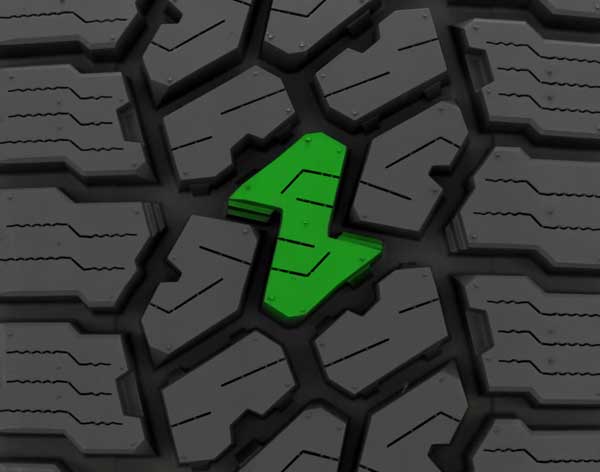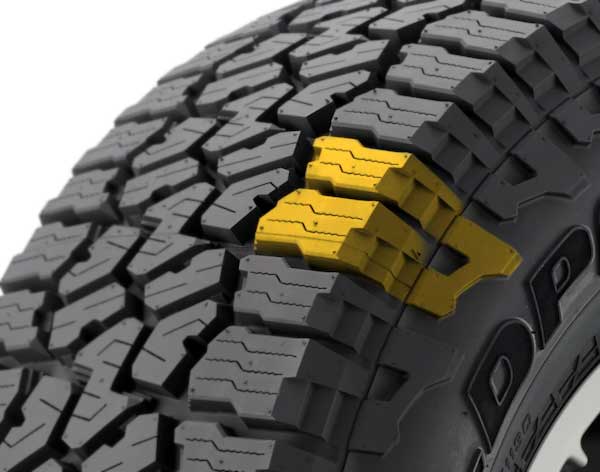Both the Yokohama Geolandar AT G015 and the Falken Wildpeak AT3w are all terrain tires, where the Geolandar is more focused towards performing on road, while the Wildpeak AT3w offers better traction off road.
The Yokohama AT is famous for it’s comfortable on road ride and snow performance (earning 3PMSFR), while the Falken Wildpeak AT3w offers better dry traction on highways, and

Table of Contents
Sizes and Construction
Overall, the Geolandar AT is available in more sizes, and has larger load and speed ratings in comparison, so it makes sense why it’s weight range is also greater.
| Falken Wildpeak AT3w | Yokohama Geolandar G015 | |
| Available sizes | 15″ to 22″ | 15″ to 22″ |
| Load Range | SL, XL, C, D, E, and F | SL, XL, C, D, E |
| Speed Rating | Q, R, S, T, and H | R, S, H |
| Weight Range | 35 lbs to 84 lbs | 27 to 70 lbs |
| Tread Depth Range | 12 to 19/32″ | 11 to 18/32″ |
| Sidewall Construction | 2 ply + 2 polyamide layers | 2 ply |
Tread Design
Starting with one of the most comfortable A/T tires you can get your hands on, the Yokohama Geolandar AT G105 offers 3 main ribs in the middle, where the central most is continuous, meaning it does not make proper lateral grooves in between, as they are joined together by a rubber rib underneath.

Same is the case with the outer two ribs, they also have dual compound as all blocks here are also joined together with another layer underneath. This provides this tire with directional stability (for the most part).
Talking about shoulders, the Tire offers lugs with notches notches facing inwards, along with full depth siping, as shown below.

Towards outer margins, it although does not offer serrated shoulder blocks, it still has stepped edges that help in chewing off road. So you can say each lug is staggered on itself.
These blocks extend towards the sidewalls, where the tire makes an irregular pattern, which helps when you lower the pressure down on the tire (flexing sidewalls).
If we look at it’s competitor, Falken Wildpeak AT3w. We see a more aggressive tread pattern thanks to tire’s decent number of biters.
It features Z shaped blocks in the middle having stair-shaped notches called ramps. And these lugs are then surrounded with C shaped blocks, which are also equipped with notches and foundation supports.
The Z shaped lugs are highlighted below.

Moreover, the Wildpeak also makes wide outer channels, and feature a more interconnected tread voids (both laterally and longitudinally).
Moving towards the shoulders, they are again pretty aggressive, with their elongated structures.
They features notches and ramps just like seen in the middle, though unlike them, they also have interlocking sipes.
Furthermore, towards their outer edges, they feature saw toothed edges, and U shaped lugs.

The U shaped sidewall lugs which join the shoulder blocks are thicker and offer a powerful bite off road when you lower tire’s air pressure.
The Yokohama G015 is missing with this feature.
Winter Performance
Winter performance has a lot of variables, mainly due to different types of land. There are deep fluffy terrains, then theres packed up snow and ice and snow on.
And overall both tires are pretty commendable, having M+S and 3 Peak Mountain Snowflake ratings.
FYI: The 3pmsf rating basically tell you that the tire’s snow acceleration ius 10% better compared to the average all-season tire without this rating.
But still overall, comparing performance through tests, its seen that the Falken Wildpeak AT3w gets to have an upper hand, due to it’s dual siping structure and more number of biters, allowing to hold snow in a better way.
That lodged (in grooves and biters) snow then account for superior snow to snow contact, and minimize rubber’s exposure with the ground, which does not produce as much friction.
Though I have to add that the Geolandar’s softer compound plays a vital role here. It remains pliable in freezing temperatures, and helps its biters in a better way to grip snow and ice areas effectively.
In simpler words, it’s tread has superior thermal adaptability compared to Wildpeak.
Ride Comfort
The Yokohama Geolandar G015 is among the most comfortable all-terrain tires. Not just saying. We have actually tested all of these A/T tires and have given Geolandars the highest scores when it comes to bumps absorption especially.
Moreover, the tire’s road noise reduction capability is also pretty appreciable. I mean the Geolandar still manages to come in top 5 quietest all terrain tires. (the quietest A/T is Continental TerrainContact A/T, just FYI).
So what makes the tire so comfortable? Well its tread compound and inner cap plies. Both of these work in harmony to dampen down the vibrations of the road, before they reach you.
Now the Wildpeak AT3w is also commendable in this department. It’s vibrations settling ability is although not as great compared to its competitor, but it’s still good enough, especially when you consider its tread depth.
(It’s greater tread depth allow for larger room for shocks to settle down).
Tread Life and Fuel Usage
The tread and fuel usage both depend on rolling resistance values, along with tread depth and composition.
Having said that it makes sense why the Yokohama G015 with much lighter overall structural weight offers better fuel economy. That’s because it’s easier to carry around lighter weight, stating the obvious.
Though in case of tread life, both tires are rated equal.
The Wildpeak may face faster burning of its rubber, its saved up by its greater tread depth, which takes longer to reach down to replacement levels.
Whereas the Yokohama Geolandar A/T features a more streamlined on-road oriented design allowing for similar tread life capability.
That’s why both tires offer similar warranties as well.
Yokohama offers a 50k-mile warranty for LT sizes and 60k for non LT, P metric sizes, while the Wildpeak gives you 66k miles warranty on all.
Dry Performance
When it comes to dry roads although all terrain tires aren’t as capable of performing as well as passenger tires, there are still some on road oriented tires that do surprisingly well, and both of our tires here are in that list.
Both of them feature close enough lug arrangement, allowing for decent braking distances and handling times.
Though the steering response of Wildpeak AT3w could be improved.
Basically the tire with heavier weight causes its lugs to flex more during cornering, and this creates a greater duration between over and under-steering.
That’s why the Geolandar would allow for better turning abilities. But other than that, both tires are great.
Wet Performance
Wet traction is complex, involving both grip and hydroplaning.
The grip part comes form sipes, while resistance to hydroplaning is achieved by the grooves.
Now in term of later metric, both tires have no issue, as both of them features decent tread voids to channel water out in all directions, allowing for good enough curved and straight float speeds (max speed a tire achieves without floating on standing water).
But in terms of grip, things get a little different.
In this regard, the Falken Wildpeak AT3w takes the cake. In fact its one of the best in A/T tires when it comes to wet performance.
Simply put, the tire features dual siping, and greater number of biting edges, so with them water is cleared off in a better way.
The Geolandar A/T although also feature good number of siping, they are still not as effective in soaking up water particles as the Wildpeak.
Durability
Both tires come with a dual-layer polyester casing and two wide steel belts on top.
And on top of these belts they both have 2 ply nlyon cap plies, where the Yokohama Geolandar AT has spirally-wound ones.
Basically, its worth mentioning here because the spirally-wound nylon reinforcement in the Yokohama G015 better safeguards the sidewalls without adding much weight.
Additionally, this design slightly improves the Geolandar’s lateral stability compared to on-road oriented A/T tires.
Though that does not mean the tire has greater durability compared to Falken Wildpeak AT3w. No Sir.
The Wildpeak features 2 extra ply of polyamide running around the tire’s rim, protecting the sidewalls.
So you can say, the tire has actually 4 layers of polymer underneath it’s sidewalls, giving you superior puncture resistance.
Off Road Performance
Off-road is another area, where the Falken Wildpeak has the upper hand.
On muddy tracks, where you need a voided tread design, the Falken Wildpeak AT3w with it’s interconnected lateral and circumferential groove offer superior cleaning abilities.
While the Yokohama Geolandar A/T G015 having continuous running (longitudinal) ribs restrict mud-flow (especially sideways) and cause mud packing (leading to loss of complete traction).
Similarly on rocks, with the Wildpeak’s bigger groove mouth, you get superior climbing abilities.
Whereas the Geolandar with it’s directional arrangement of lugs lacks in offer good enough lateral traction.
And then there is a durability factor as well, and Wildpeak is much superior there as well, as explained in the topic above this one.
To conclude
The Yokohama Geolandar A/T G015 ranks among the top all-terrain tires in terms of comfort and road noise reduction, delivering a remarkably smooth ride, while the Falken Wildpeak AT3w gets the title of epic wet traction capability.
Other than that, in terms of “dry” grip, both tires are simply great, and there are no complaints there.
However, the Yokohama A/T G015 gives you superior fuel economy, but in terms of treadwear, you can say both tires are same.
In terms of winter traction, the Wildpeak AT3w takes the larger piece of the pie, despite both tires having 3 peak mountain snowflake ratings.
And same goes for off-road performance, where the Wildpeak excels in almost all types of terrains, especially on muddy and rocky tracks.